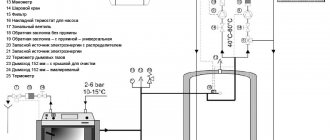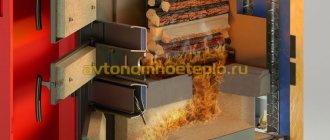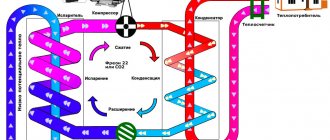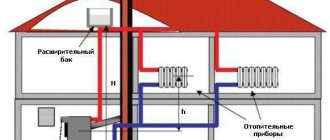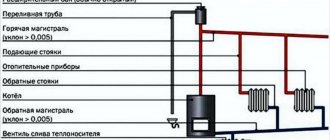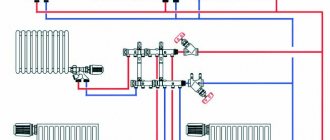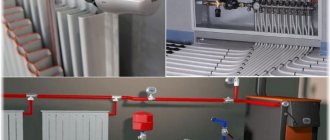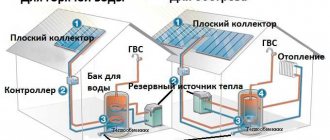Solid fuel boilers continue to hold a strong position in the heating equipment market. Modern models are able to squeeze out maximum thermal energy from firewood, coal and briquettes, and transfer it to the coolant with minimal losses. Automation for solid fuel boilers helps improve the quality of work and simplify maintenance and operation. A very effective way to control the combustion process and maintain a given coolant temperature is achieved simply by the presence of a blower fan and a command controller that controls it and the circulation pump.
How does it work
It seems very difficult to control the combustion process of coal or wood. At all times, setting up a boiler was purely individual for each boiler, was done manually and required a lot of experience and skill. As a good result, maximum efficiency was achieved in combination with fuel economy. However, if the settings were incorrect, most of the heat simply flew out into the chimney.
The automation process, which has long become commonplace for any other types of boilers, has also reached solid fuel boilers. It turned out that it was enough to use a very limited set of tools and sensors to ensure a controlled combustion process, increase the safety of boilers and accurately maintain the temperature of the water in the heating circuit.
Automation for solid fuel boilers includes:
- blower fan;
- controller;
- circulation pump (optional);
- draft regulator (optional).
The operating principle of the automation is extremely simple. It is enough to take over the control of the blower and control the volume of air entering the combustion chamber to ensure optimal fuel combustion and the safe operation of all boiler equipment.
The fan is installed instead of a standard damper, through which fresh air enters the combustion chamber. The controller controls the fan and, in accordance with the settings, is able to change the volume of incoming air:
- If it is necessary to obtain maximum thermal power, the fan turns on at full speed and supplies a large volume of air saturated with oxygen. Active combustion of fuel is accompanied by an increasing output of thermal energy
- In operating mode, the fan switches to moderate speed and maintains combustion at the optimal level necessary to obtain the desired coolant temperature.
- If the target water temperature in the circuit overheats or decreases, the fan stops and without access to oxygen, the fuel only barely smolders, releasing a minimal amount of heat.
A similar cycle is repeated over and over again, providing, albeit stepwise, regular combustion control.
The reference data for the controller is the readings of the water temperature sensor in the boiler. In fact, this is enough to ensure normal operation of the automation. In addition, some types of automation control the temperature of the exhaust gases entering the chimney, the temperature outside the house and inside the room. In this case, additional protection and safety is provided, and the possibility of advanced boiler settings with automatic correction of the target water temperature in the boiler and the ability to control heating to maintain a comfortable temperature in the house appear.
In addition to the controlled fan, the automation can control the circulation pump to promote constant and even distribution of heat throughout the heating circuit. By increasing or decreasing the speed of water circulation in the circuit, you can influence the efficiency of heat transfer from the combustion chamber to the coolant, directly increasing the efficiency of the boiler.
Additional functions of the solid fuel boiler automation unit may include:
- GSM module for remote control of the boiler operation and the possibility of remote configuration.
- Planning the operation of the boiler, according to the schedule, setting the desired temperature depending on the time of day and day of the week.
- Introduction of a solid fuel boiler into the overall Smart Home control system.
Automation operation diagram
With automation for solid fuel boilers, there is no longer any need to constantly and independently monitor its operation, adjust damper settings, or worry about the fact that the fuel will be wasted or clearly ineffective. In addition, real cost savings result, because with precise adjustment and constant control of fuel combustion, less fuel is spent, used more efficiently and purposefully. The controller monitors the condition of the water and controls the combustion process 24 hours a day every day throughout the heating season.
The cost of automation for solid fuel boilers, if we take offers from the average price range, is comparable to the cost of fuel for half the heating season or even a third. If we take into account that using the controller saves fuel on heating, the equipment will pay for itself in literally two to three seasons. And yet, the main advantage remains that the user does not have to, as before, check the operation of the boiler every half hour or hour and adjust it in the hope of obtaining the desired water temperature, moreover, with a large error.
Automation for solid fuel boilers is often produced by manufacturers that are not directly involved in the production of boilers. These are firms and companies that specialize, in principle, in process automation. Therefore, it will be useful to find out the list of the most common and already proven manufacturers of command controllers on the market.
Design and operating principle
The automation that controls the operation of a gas boiler consists of many elements, conditionally divided into two subgroups. The first includes mechanisms that ensure the full and safe functioning of the boiler itself. The second includes devices that make it possible to operate the heating system in the most convenient and user-friendly mode.
Components of a security system
Several modules are responsible for the operational safety of the unit:
- Flame controller - consists of two main parts - a solenoid valve and a thermocouple. Shuts off gas promptly and reliably and prevents leakage.
- Thermostat - maintains the set temperature of the coolant and protects the system from overheating. When the coolant cools down to minimum temperatures, the module starts the boiler into operation, and after recording peak-high readings, it turns it off, completely relieving the owners of the need to constantly pay attention to the system.
- The draft control sensor is responsible for stopping the gas supply to the burner in the event of a change in the basic position of the bimetallic plate, thus preventing gas leakage.
- Safety valve - monitors the amount of coolant in the circuit.
In addition to all the above useful qualities, the automation has a number of additional functions that increase the comfort of using the equipment.
The device performs automatic ignition of the gas burner, selects the most effective operating mode, promotes rational consumption of energy resources and conducts independent diagnostics, saving the owners from all these activities.
Operating principle of security automation
Current regulatory documentation says that the safety system for gas boilers must be equipped with a device that stops the operation of the entire system and shuts off the gas supply in the event of an unexpected breakdown or any other force majeure circumstances.
Atos
- Manufacturer: Poland;
- Power supply: 220V/50Hz;
- Connected pump power: up to 130W;
- Fan power: up to 130 W;
- Coolant temperature setting range: 35-80°C;
- Temperature measurement accuracy: 1°C
- Room temperature setting range: 25-50°C;
- Alarm when the set temperature range is exceeded;
- Relay output for additional alarm;
- Manual target temperature setting and circulation pump control.
- Estimated cost: 6750 rub.
Automation originally from Poland has proven itself well in combination with heating boilers of various types and designs with a capacity of 25-50 kW. Among the advantages is the possibility of igniting fuel in any weather conditions, increasing the efficiency of the boiler while maintaining a stable coolant temperature, according to the set value.
The control unit is compact, with a simple interface and a two-digit dial for setting all key parameters.
Price and reviews
The cost of an automated system is influenced by the technical indicators and functionality of the device. Thus, the price of the simplest mechanical model varies within 1.5 thousand rubles.
The price range of more progressive options is from 25,000 rubles to 100,000 rubles. The more expensive the model, the higher the ergonomics of the heating system will be, and the resource consumption will be correspondingly lower. Therefore, it is more advisable to give preference to more expensive options.
READ How to install car audio yourself
Reviews:
Nikolai Viktorovich. “The control unit from the Krypton company is one of the best devices today. It is distinguished by the quality of its components; the kit includes a sensor, cords for connecting to the fan and pump, a clamp, and adapters. A reliable device from a Polish manufacturer.”
Fedor. “On the recommendation of a friend, I installed the ATOS automatic, its performance characteristics are excellent.”
Anatoly Yurievich. “The Proton automation surprised me with the presence of additional components in the package (a clamp for attaching the sensor, a stand for the unit, self-tapping screws). The device is efficient, reliable and easy to use. ”
Air
- Manufacturer: Ukraine;
- Power supply: 220V/50Hz;
- Connected pump power: up to 450W;
- Fan power: up to 220 W;
- Coolant temperature setting range: 40-85oC;
- Temperature measurement accuracy: 0.1°C
- Room temperature setting range: 20-45oC;
- Estimated cost: 3000-3500 rubles.
Compact automatic control unit for solid fuel boilers. Allows installation and control of a powerful circulation pump and fan with a corresponding load current of 2 and 1 ampere; the modification allows load currents of up to 5A.
Types of solid fuel boilers
The operating principle of solid fuel boilers allows them to be part of various modern schemes. We are talking about both the simplest single-circuit devices and the most powerful multifunctional units with high performance. There are several ways to classify solid fuel equipment.
According to the material of manufacture:
- Of steel . The cost of steel appliances is lower than that of cast iron. In addition, they are easier to maintain: cleaning takes place without any problems. One of the disadvantages is the sensitivity of the models to the temperature in the return pipe: it must be at least +60 degrees. This involves the use of special valves to maintain the required temperature by mixing hot water from the supply pipe into the return.
- Made of cast iron . They are characterized by higher durability, but require complex maintenance. The use of cast iron solid fuel boilers is recommended in case of continuous use. Purchasing an ultra-reliable cast iron unit only for emergencies is not a practical solution. Cheaper steel models can cope with such tasks.
Tech
- Manufacturer: Poland;
- Power supply: 220V/50Hz;
- Connected pump power: up to 200W;
- Fan power: up to 200 W;
- Coolant temperature setting range: 30-80°C;
- Temperature measurement accuracy: 1°C;
- Room temperature setting range: 20-45oC;
- Manual target temperature setting and circulation pump control.
- Estimated cost: 6500-7250 rubles.
Functional control unit with practical overheat-protected housing. User-friendly interface. The presence of an LCD display and an expanded set of control keys makes it easier to configure the automation and control the operation of the boiler.
Why are regulators needed?
Note. At the very least, the boiler, without any automation, can work together with a buffer tank - a heat accumulator, whose volume is correctly calculated. Excess heat will go there if you did not close the door in time and did not limit the flow of air into the firebox.
An automatic chimney draft regulator, which you can install on any solid fuel boiler yourself, will supply air for you and much better than you. It will react in time to an increase in the temperature of the water in the boiler jacket and shut off the air supply to the chamber if the firewood gets very hot. Although, by inertia, the temperature will rise for some time, but in general the heating process will stop. In addition to ensuring safety, a mechanical boiler draft regulator helps solve the following issues:
You may argue that any solid fuel heat generators should be connected to the heating system using a safety valve set to emergency pressure. If it overheats, the valve will work, release steam and no explosion will occur. So the draft regulators seem to be of no use. The statement is only partly true, since without automation the heater will often reach a critical temperature, and the valve will simply leak after 2-3 operations. Yes, and controlling the water temperature manually is quite difficult.
Comfort Eco
- Manufacturer: Poland;
- Power supply: 220V/50Hz;
- Connected pump power: up to 300W;
- Fan power: up to 300 W;
- Coolant temperature setting range: 35-80°C;
- Temperature measurement accuracy: 1°C;
- Room temperature setting range: 20-45oC;
- Estimated cost: 7900-8200 rub.
Compact control unit mounted on the boiler body with simple controls and a two-digit dial. Allows you to adjust the operation of the boiler depending on the set target temperature in the heated room. Provides boiler protection from overheating and freezing.
How to connect and configure
Installation of any automation for a solid fuel boiler is approximately the same. You need to follow a number of simple steps:
- Place the automation unit in a place inaccessible to overheating. It is not at all necessary to install the automation unit very close to the boiler or on its body. It is much more important to define it in such a way as to avoid overheating, even taking into account possible emergency situations. The maximum distance is determined by the permissible length of cables for connecting the fan, circulation pump and sensors, which can range from 2 to 10 meters.
- Connect a fan to supply air on the combustion door instead of the ash damper or in a separately prepared hole. For older boiler models, you will have to manually cut and prepare a hole for the fan. In modern boilers, installation is carried out in a prepared place.
- Install the coolant temperature sensor. It is best to measure the water temperature directly in the boiler heat exchanger or inside the main heat storage tank. For this purpose, boilers often provide a special seat or hole up to 60 mm deep. If it is not possible to fix the sensor on the heat exchanger, then it is transferred to the boiler outlet pipe through which the hottest coolant flows. More often, the manufacturer advises using a clamp with a thermal pad for better contact.
- Connect all equipment to the controller using power and signal wires. For the fan, circulation pump and sensors, corresponding pairs of terminals are allocated, mounted on the body of the automation unit. Their markings and position should be checked with the instructions from the manufacturer.
- The initial settings are set: target coolant temperature. The maximum and minimum volume of air supplied by the fan to the combustion chamber. Limits of permissible change in water temperature in the boiler.
The programming algorithm and settings of the automatic control unit for solid-fruit boilers are established by the manufacturer and are described in detail in the instructions.
Firewood and coal in TT boilers
Today, heating with coal in Russia is unprofitable, which cannot be said about wood heating. Firewood In many regions of Russia, firewood is cheaper than gas, but from a practical point of view it has noticeable disadvantages:
- firewood must be prepared correctly;
- fuel burns quickly in the furnace compartment, so the process must be controlled;
- If the fire burns out completely, you have to periodically add firewood to the boiler.
As an alternative, many people choose coal. This is also a solid fuel, and also cheaper than gas. If you buy an automatic long-burning solid fuel boiler with automation, you will solve the problem of saving money and time (you don’t have to be on duty at the firebox). However, it must be taken into account that not all coal is good for TKDG.
